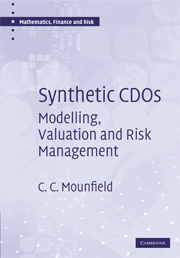Book contents
- Frontmatter
- Contents
- Preface
- Acknowledgements
- 1 A primer on collateralised debt obligations
- 2 Modelling of obligor default
- 3 Valuation of credit default swaps
- 4 Credit indices
- 5 Valuation of default baskets
- 6 Valuation of synthetic CDOs
- 7 Phenomenology of the standard market model
- 8 Risk quantification of synthetic CDOs
- 9 Implied and base correlations
- 10 Extensions of the standard market model
- 11 Exotic CDOs
- 12 Correlation trading of synthetic CDO tranches
- 13 Risk management of a portfolio of synthetic CDOs
- 14 Hedging simulation of structured credit products
- Appendix A Explanation of common notation
- Appendix B Simulated annealing
- References
- Index
10 - Extensions of the standard market model
Published online by Cambridge University Press: 06 July 2010
- Frontmatter
- Contents
- Preface
- Acknowledgements
- 1 A primer on collateralised debt obligations
- 2 Modelling of obligor default
- 3 Valuation of credit default swaps
- 4 Credit indices
- 5 Valuation of default baskets
- 6 Valuation of synthetic CDOs
- 7 Phenomenology of the standard market model
- 8 Risk quantification of synthetic CDOs
- 9 Implied and base correlations
- 10 Extensions of the standard market model
- 11 Exotic CDOs
- 12 Correlation trading of synthetic CDO tranches
- 13 Risk management of a portfolio of synthetic CDOs
- 14 Hedging simulation of structured credit products
- Appendix A Explanation of common notation
- Appendix B Simulated annealing
- References
- Index
Summary
Introduction
The existence of transparently observable, liquid index tranche prices means that valuation models now have a calibration target. If this target is not hit by a model then someone relying on that model for pricing will be susceptible to being arbitraged. However, the plain vanilla incarnation of the Gaussian copula model introduced and analysed in previous chapters is incapable of hitting this target. The model must therefore be extended to meet this new challenge. Some of the different methods that have been proposed for calibrating synthetic CDO tranches to the market are the topic of this chapter.
In Section 10.2 we briefly recap what the fundamental shortcomings of the standard Gaussian copula model are and then discuss how the basic model can be extended to overcome these shortcomings. There are two basic approaches for doing this. One approach is to change the dependence structure used to characterise the coupling between obligors (but still within the framework of the single factor model). Other approaches are more radical in their deviation from the standard market model, removing the assumption of deterministic correlation (stochastic correlation models) or using an entirely different framework to the copula models (gamma models). Section 10.3 then briefly discusses portfolio loss models. These models take the approach of treating the portfolio loss as the fundamental stochastic variable to be modelled. They represent the current state-of-the-art in synthetic CDO modelling. Because they are cutting edge, these models have yet to gain widespread acceptance amongst practitioners.
- Type
- Chapter
- Information
- Synthetic CDOsModelling, Valuation and Risk Management, pp. 204 - 223Publisher: Cambridge University PressPrint publication year: 2008



